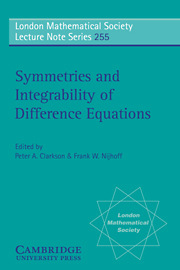Book contents
- Frontmatter
- Contents
- Preface
- List of Participants
- 1 Partial Difference Equations
- 2 Integrable Mappings
- Integrable symplectic maps
- An iterative process on quartics and integrable symplectic maps
- Integrable mappings of KdV type and hyperelliptic addition formulae
- R-matrix hierarchies, integrable lattice systems and their integrable discretizations
- 3 Discrete Geometry
- 4 Asymptotic Analysis
- 5 Discrete Painlevé Equations
- 6 Symmetries of Difference Equations
- 7 Numerical Methods and Miscellaneous
- 8 Cellular Automata
- 9 q-Special Functions and q-Difference Equations
- 10 Quantum Aspects and Yang-Baxter Equations
An iterative process on quartics and integrable symplectic maps
Published online by Cambridge University Press: 04 August 2010
- Frontmatter
- Contents
- Preface
- List of Participants
- 1 Partial Difference Equations
- 2 Integrable Mappings
- Integrable symplectic maps
- An iterative process on quartics and integrable symplectic maps
- Integrable mappings of KdV type and hyperelliptic addition formulae
- R-matrix hierarchies, integrable lattice systems and their integrable discretizations
- 3 Discrete Geometry
- 4 Asymptotic Analysis
- 5 Discrete Painlevé Equations
- 6 Symmetries of Difference Equations
- 7 Numerical Methods and Miscellaneous
- 8 Cellular Automata
- 9 q-Special Functions and q-Difference Equations
- 10 Quantum Aspects and Yang-Baxter Equations
Summary
Abstract
An iterative process on closed curves is considered, which is relevant in the context of the Dirichlet problem for the Wave equation. Such iterative process is symplectic and integrable, being related to a special case of the integrable symplectic map denoted as Discrete Gamier System. Its explicit solution in terms of Weierstrass functions is derived.
Introduction
In this short note, we will rederive a classical result concerning the Dirichlet Problem on a closed curve taking advantage of some recent findings in the area of integrable symplectic maps.
Accordingly, Section 2 is devoted to recall how, in a natural way, the Dirichlet problem on a suitable region D in the plane can be associated with an iterative process T on its boundary Γ.
In Section 3, we will introduce an integrable symplectic map that obtains as a “degenerate” (in a sense that will be clarified later) case of a discrete analog of the Gamier System, and will elucidate its geometric meaning.
In Section 4, an iterative process on a closed curve in the plane will be obtained as a “reduced system” from the above symplectic map, and its explicit solution in terms of elliptic functions will be derived.
An iterative process on closed curves
Dirichlet problem for the wave equation
Suppose that D is a region on the plane, convex in the coordinate directions, i.e. its boundary Γ = ∂D intersects each line x = c, y = c at not more than two points.
- Type
- Chapter
- Information
- Symmetries and Integrability of Difference Equations , pp. 56 - 63Publisher: Cambridge University PressPrint publication year: 1999
- 2
- Cited by

